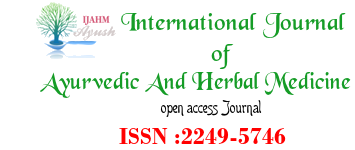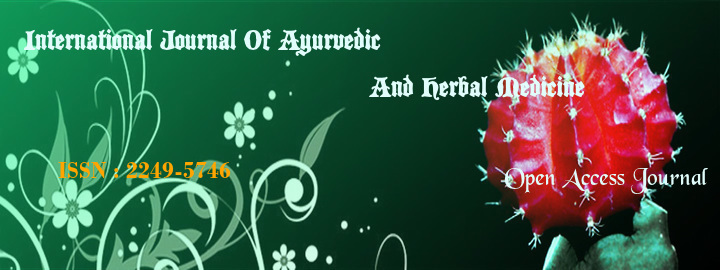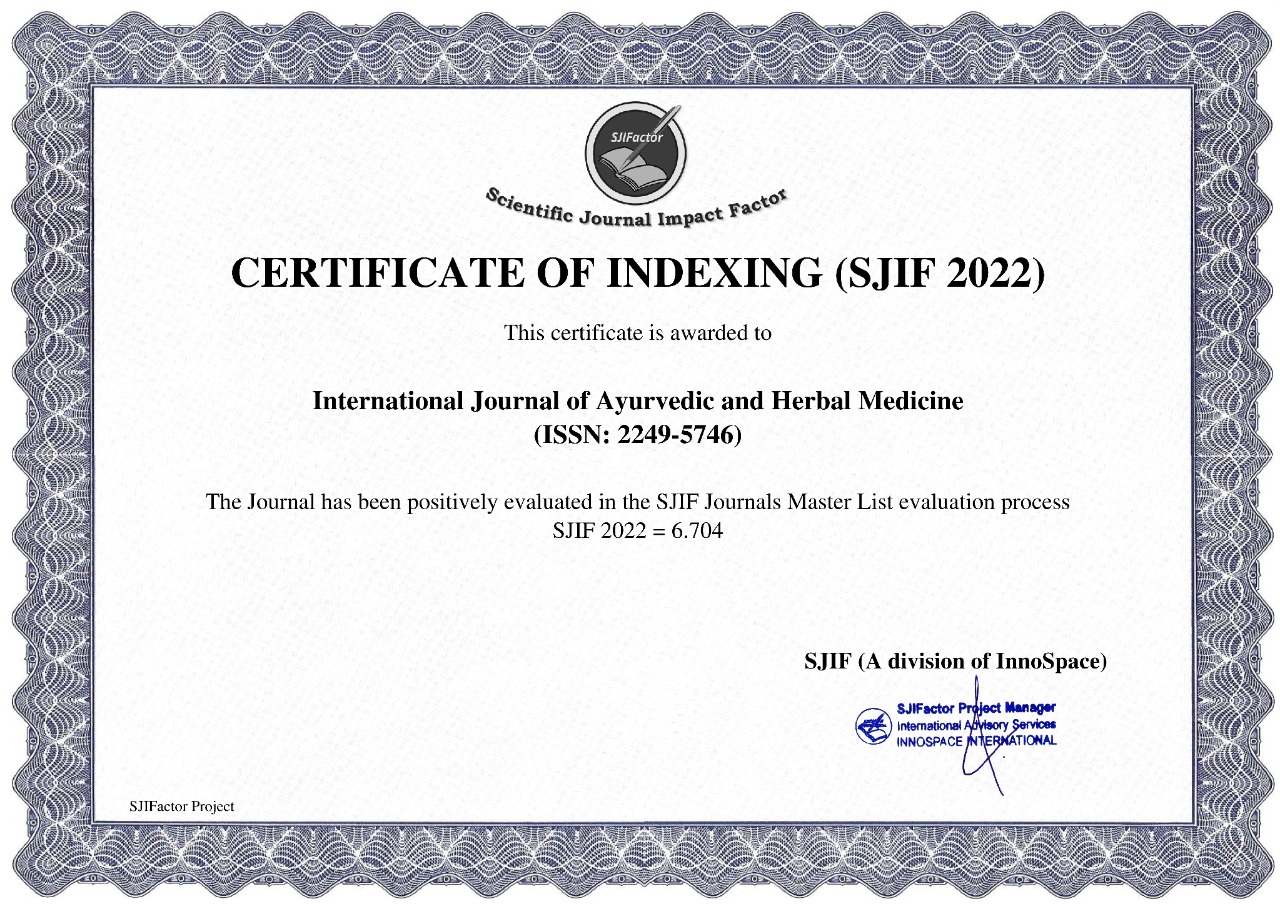


Dodke P. C.1*, Pansare T. A.2
1PG Scholar (Dravyaguna),Government Ayurvedic College, Osmanabad, Maharashtra
2Associate professor of Dravyaguna Department, Government Ayurvedic College. Osmanabad, Maharashtra.
Abstract
Due to globalization the Ayurvedic science has been reached to every corner of the world. This science of life is well accepted today by many of countries and positive response to Ayurvedic is increasing day to day. The use of herbal drugs for prevention and treatment of various health ailments has been practice since time immemorial Terminalia chebula Retz. (Family-Combretaceae) is traditionally recommended by the Indian Ayurvedic medicine for treatment of several disorders. According to Ayurveda, due to its Rasayana (rejuvenating), and Vayasthapana (age-sustaining) actions it provides long healthy life and fights against variety of diseases. It is endowed with diverse pharmacological activities like antidiabetic, anti arthritic, Hepatoprotective, antioxidant, anti plasmodia activity etc. It contains many important Phytochemicals such as chebulic acid, Gallic acid, ellagic acid, tannic acid, amino acids, flavonoids like luteolin, rutins and quercetin etc. It also consists of nutrients such as vitamin C, protein, amino acids and minerals. The present review is an effort to highlight the various traditional uses as well as Phytochemical and pharmacological activities reported so far from Haritaki which will surely help researchers to explore it at molecular level and pharmaceutical industries to develop a new product
Keywords:
Terminalia chebula , Haritaki, Phytochemical, pharmacological
References
1. Padhi M, Mahapatra S. Evaluation of Antibacterial Potential of Leaf extracts of Mimusops elengi. Int Res J Biological Sci 2013; 2(7):46-49. 2
2. Padhi M, Mahapatra S, Panda J, Sahoo BM. Phytochemical and pharmacological review of Mimusops elengi Linn. American Journal of Pharm Tech Research 2012; 2(6):213-230.
3. Ammar S, Michael H, Pirkko H, Kalevi P (2002). Inhibition of Cancer Cell Growth by Crude Extract and the Phenolics of Terminalia chebula Fruit. J. Ethnopharmacol. 81:327-336.
4. Chattopadhyay RR, Bhattacharyya SK (2007). Plant Review Terminalia chebula. Pharmacognos. Rev. 23:145-150.
5. Karel DK, Ammar S, Jari S, Marja K, Jyrki L, Peteri T, Kalevi P (2004). The Structural and Conformational analyses and antioxidant activities of Chebulinic acid and its thrice-hydrolyzed derivative,2,4-chebuloyl- ß-d-glucopyranoside,isolated from the fruit of Terminalia chebula. ARKIVOC. 7:83-105
6. Bhavprakash nighantu, Dr.G.S Pandy, Chaukhamba bharti academy, Varanasi. 2013,pg 4
7. Dravyaguna-vijnana,P.V. Sharma, Chaukhabha Bharti Academy ,Varanasi,Reprint 2015,vol 2,pg.753.
8. http:// ayurvista. Blogspot. in /search?q= Terminalia+
9. R.Rathinamoorthy and G.Thilagavathi Terminalia Chebula-Review on Pharmacological and Biochemical Studies. International Journal of PharmTech Research CODEN (USA): IJPRIF ISSN: 0974-4304.Vol 6, No.1, pp97-116, Jan- March.
10. Charak Samhita, Kashinath Sastri,Chaukhambha Bharti Academy, Varansi, Reprint 2013.
11. http://easyayurveda.com/2013/01/05/haritaki-terminalia-chebula-uses-side-effects-ayurveda-details/
12. https://mavcure.com/haritaki-terminalia-chebula-health-benefitsusesside-effects/
13. dhanvantri nighantu
14. http://www.evaidyaji.com/Ayurvedic/Ayurvedic%20Harbs/haritaki
15. Anonymous; “The Wealth of India, Raw Materials”. CSIR, New Delhi, 171-175 (2003)
16. P. C. Sharma, M. B. Yelne, T.J.Dennis; Database on Medicinal Plants Used in Ayurveda. Central Council for Research in Ayurveda and Siddha, 282-286 (2005).
17. Yadav Babita, Keshipeddi Sandhya Rani, Bhat Sulochna Singh Mamta. A Perspective study of Haritaki, International Journal of Research in Ayurveda and Pharmacy 2011, 2(5), 1466-1470.
18. V.I.Hukkeri, M.P.Joshi, M.N.Deshpande, S.K.Nagare, A.M.Korgaonkar. Phyto-pharmacological review of Terminalia chebula Retz. Natural Products an Indian Journal.6 (1), 2010 [24-28].
19. Anonymous; the Ayurvedic Pharmacopoeia of India, Part I. Govt. of India: Ministry of Health & Family Welfare, I, 47-48 (1989).
20. Anonymous; Indian Pharmacopoeia, the Indian Pharmacopoeia Commission, 3, 2041-42 (2007).
21. Kumar KJ. Effect of geographical variation on contents of tannic acid, Gallic acid, chebulinic acid and ethyl gallate in Terminalia chebula. Natural Product 2006; 2(3-4):170-75.
22. Pulliah T. Encyclopaedia of world medicinal plants. New Delhi, India: Regency Pub Vol 4 pp 1931-1934.
23. Srivastava A, Chandra A, Singh M Jamal F, Rastogoi P, Rajendran SM, Bansode FW, Lakshmi V. Inhibition of hyaluronidase activity of human and rat spermatozoa in vitro and antispermatogenic activity in rats in vivo by Terminalia chebula, a flavonoids rich plant. Reproductive Toxicol 2010; 29:214-24.
24. Kundu AP, Mahato SB. Triterpenoids and their glycosides from Terminalia chebula. Phytochemistry 1993; 32(4); 999-1002.
25. Saleem A, Husheem M, Harkonen P, Pihlaja K. Inhibition of cancer cell growth by crude extract and the phenolics of Terminalia chebula Retz. Fruits J Ethnopharmacol 2002; 81:327-36.
26. Arora S, Kaur K, Kaur S. Indian medicinal plant as a reservoir of protective Phytochemicals. Teratogenesis, Carcinogenesis, and Mutagenesis 2003; 23(S1): 295-300.
27. Reddy DB, Reddy TCM , Jyotsna G, Sharan S, Priya N, Lakshmipathi V, Reddann P. Chebulagic acid, a COX–LOX dual inhibitor isolated from the fruit of Terminalia chebula Retz. Induces apoptosis in COLO-205 cell line. J Ethnopharmacol 2009; 124(3):506-12.
28. 25. Dutta BK, Rahman I, Das TK. Antifungal activity of Indian plant extracts. Mycoses 1998; 41(11-12):535-36.
29. Mehmood Z, Ahmad I, Mohammad F, Ahmad S. Indian medicinal plants: A potential source for anticandidal drugs. Pharmaceutical Biology 1999; 37(3):237–42.
30. Vonshak O, Barazani P, Sathiyomoorthy R, Shalev D, Vardy A Golan-goldhirsh. Screening of South-Indian medicinal plants for antifungal activity. Phytotherapy Res 2003; 17(9):1123-25.
31. Shinde SL, More SM, Junne SB, Wadje SS, The antifungal activity of five Terminalia species cheaked by paper disk method. Int J Pharma Res and Develop 2011;3(2)
32. Khan KH, Jain SK. Regular intake of Terminalia chebula can reduce the risk of getting typhoid fever. Adv Biotech 2009; 8 (9): 10-15.
33. Khan KH. The effect of regular intake of Terminalia chebula on oxidative stress in mice originated from Salmonella typhimurium. EurAsia J BioSci 2009; 3: 113-121.
34. Malckzadeh F, Ehsanifar H, Shahamat N, Levin M, Colwell RR. Antibacterial activity of black myrobalan (Terminalia chebula Retz.) against Helicobactor pyroli. Int J Antimicrob Agent 2001; 85-88.
35. Kannan P, Ramadevi SR, Hopper W. Antibacterial activity of Terminalia chebula fruit extract. African J Microbiol Res 2009; 3(4) p. 180-84.
36. Manoj kumar et al Antimicrobial activity of aqueous extract of T. chebula. Retz on gram positive and gram negative micro organisms. Int J Current Pharma Res 2009;1(1): p. 56-60.
37. Sharma a et al. Efficacy of ethyl acetate & ether extract of T. chebula Ritz. Against some human pathogenic strengths Int J Pharmtec Res 2011:3(2): 724-27.
38. Dolly Singh et al; Therapeutical effect of extracts of T. chebula in inhibiting human pathogens and free radical. Int J Bioscience, Biochemistry & Bioinformatics 2012; 2: p-3
39. S haider raza naqvi et al. Evaluatuin of antimicrobial properties of T. chebula Retz, Pakistan journal of Pharmacology; 2010, Vol. 27(1) p. 29-35.
40. Sato Y, Oketani H, Singyouchi K, Ohtsubo T, Kihara M, Shibata H and Higuti T. Extraction and purification of effective antimicrobial constituents of Terminalia chebula Retz. against methicillin-resistant Staphylococcus aureus. Bio Pharm Bull 1997; 20(4): 401-04.
41. Malekzadeh F, Ehsanifar H, Shahamat M, Levin M, Colwell RR. Antibacterial activity of black myrobalan (Terminalia chebula Retz) against Helicobacter pylori. J Antimicrobial Agents 2001; 18:85–88.
42. Kim HG, Cho JH, Jeong EY, Lim JH, Lee SH, Lee HS. Growth-inhibiting activity of active component isolated from Terminalia chebula fruits against intestinal bacteria. J Food Prot 2006; 69(9):p. 2205-9.
43. Cheng HW, Lin TC, Yu KH, Yang CM, Lin CC. Antioxidant and free radical Scavenging activities of Terminalia chebula. Biol Pharm Bull 2003; 26(9):p. 1331-35.
44. Suchalatha S, Srinivasalu C, Devi S. Antioxidant activity of ethanolic extracts of Terminalia chebula fruit against isoproterenol-induced oxidative stress in rats. Indian J Biochem and Biophys 2005; 42:p. 246- 49.
45. Hazra B, Sarkar R, Biswas S, Mandal N. Comparative study of the antioxidant and reactive oxygen species scavenging properties in the extracts of the fruits of Terminalia chebula, Terminalia belerica and Emblica officinalis. BMC Comp Alter Med 2010; 10: 20
46. Walia H. et.al. Analysis of antioxidant activity of methanol extract / fraction of T. chebula Ritz, J Chinese clinical medicine; 2007:7(2): p. 1-12
47. Chen X, Sun F, Ma L, Wang J, Qin H, Du G. In vitro evaluation on the antioxidant capacity of triethylchebulate, an aglycone from Terminalia chebula Retz fruit. Indian J Pharmacol 2011; 43(3):p. 320-23.
48. Naik GH, Priyadarsini KI, Naik DB et al. (2004) Studies on the aqueous extract of Terminalia chebula as a potent antioxidant and a probable radioprotector Phytomedicine 11,6: p. 530-8
49. G.H.Naik et al; Phytomedicine, 11(6), 530-538 (2004).
50. Pinmai K, Hiriote W, Soonthorchareonnon N, Jongsakul K, Sireeratawong S,Tor-Udom S. In vitro antiplasmodial activity and cytotoxicity of water extracts of Phyllanthus emblica, Terminalia chebula, and Terminalia bellerica.J Med Assoc Thai. 2010;93(7):120-26
51. Bagavan A, Rahuman AA, Kamaraj C, Kaushik NK, Mohanakrishnan D, Sahal D. Antiplasmodial activity of botanical extracts against Plasmodium falciparum. Parasitol Res 2011; 108:1099-109.
52. Tasduq S, Srinivasan P, Shyamala Devi CS. Effect of Terminalia chebula (fruit) prevents liver toxicity caused by sub-chronic administration of rifampicin, isoniazid and pyrazinamide in combination. Hum Exp Toxicol 2006; 25:111-18.
53. Reddy et.al; Fitoterapia, 61(6), 571-525(1990).
54. Sugun L, Sing S, Sivakuma P, Sampat P, Chandrakasa G. Influence of Terminalia chebula on dermal wound healing in rats. Phototherapy Res 2002; 16(3):227-31.
55. V.N.Tripathi et al; Sachitra Ayurveda, 35(11), 733- 740 (1983).
56. K.Khanna et al; Fitoterapia, 64(4), 351-356 (1993).
57. Barazani VO, Sathiyomoorthy P, Shalev R, Vardy D, Golan GA. Screening of South-Indian medicinal plants for anti-fungal activity. Phyther Res 2003; 17(9): p.1123-1125.
58. Sohni YR, Bhatt RM, Activity of a crude extract formulation in experimental hepatic amoebiasis and in immunomodulation studies, J. Ethnopharmacol., 54 (2-3), 1996, 119-124.
59. Sohni YR, Kaimal P, Bhatt RM, The antiamoebic effect of crude drug formulation of herbal extracts against Entamoeba histolytic in vitro and in vivo, J. Ethnopharmacol., 45(1), 1995, 43-52.
60. Ramkrishnan Thiruchelvi et.al., Protective effects of T. chebula fruit extracts against cadmium induced nephrotoxicity in rats, Internations Journal of environmental biology, 2012;2(3): p. 108-112.
61. Anju P. Ramchandran et. al., Anti hyperlipidemic effect of VaraAsanadi Kwatha against high fat diet induced hyper lipidemic rats, Sri Lanka Journal of Indigenous Medicine, 2011; 01(02): 76-82.
62. Nair V, Singh S, Gupta YK. Anti-arthritic and disease modifying activity of Terminalia chebula Retz. In experimental models. J Pharm Pharmacol. 2010; 62(12):p. 1801-06.
63. Ramani YR, Pradhan S. Antiarthritic Activity of Acetone Extract of Terminalia Chebula. WebmedCentral Pharmacology 2012;3(2):WMC003057.
64. Moeslinger T, Friedl R, Volf I, Brunner M, Koller E, Spieckermann PG. Inhibition of inducible nitric oxide synthesis by the herbal preparation Padma 28 in macrophage cell line. Can J Physiol Pharmacol 2000; 78(11): p. 861-866.
65. Pratibha N, Saxena VS, Amit A, D’Souza P, Bagchi M, Bagchi D. Anti-inflammatory activities of Aller-7, A novel polyherbal formulation for allergic rhinitis. Int J Tissue React 2004; 26(1-2):p. 43-51.
66. Sabu MC, Kuttan R. Anti-diabetic activity of medicinal plants and its relationship with their antioxidant property. J Ethnopharmacol 2002; 81:p. 155-60.
67. Rao NK, Nammi S Antidiabetic and renoprotective effects of the chloroform extract of Terminalia chebula seeds in streptozotocin-induced diabetic rats BMC Complement Altern Med May 7: p. 6-1
68. Kannan VR, Rajasekar GS, Rajesh P, Balasubramanian V, Ramesh N, Solomon EK, et al. Anti-diabetic activity on ethanolic extracts of fruits of Terminalia chebula Retz. Alloxan induced diabetic rats. Am J Drug Discov Dev 2012; 2: p. 135-142.
69. Senthilkumar GP, Subramanian SP. Biochemical studies on the effect of Terminalia chebula on the levels of glycoproteins in streptozotocin-induced experimental diabetes in rats. J Appl Biomed 2008; 6: p. 105-115
index























